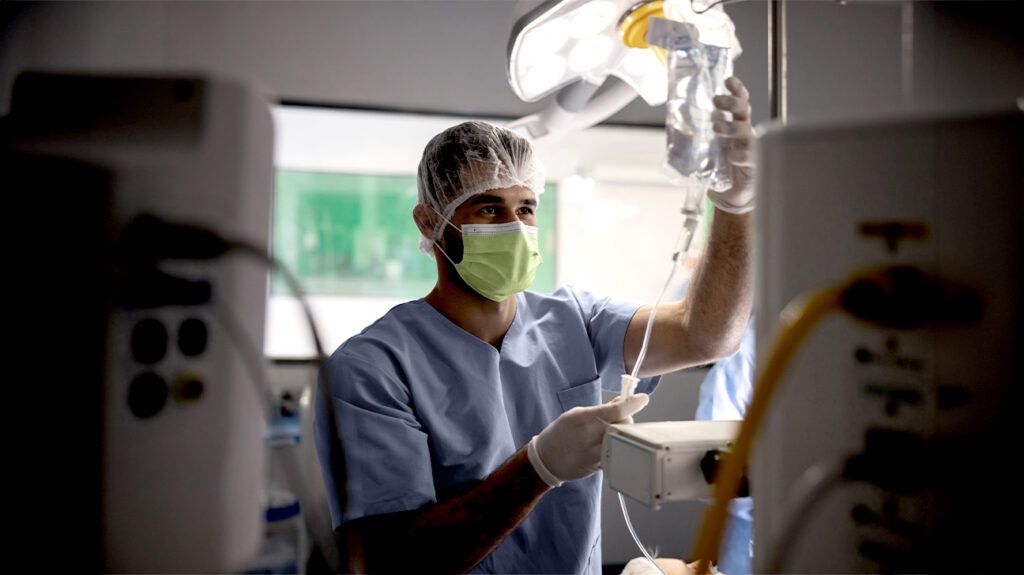MAC stands for monitored anesthesia care. It involves administering drugs to help people feel comfortable during outpatient procedures that check for or treat disease. After receiving MAC, a person will be able to follow the instructions a healthcare professional provides.
Doctors use MAC anesthesia for dental surgeries, colonoscopies, and endoscopic procedures. A person will be awake during the procedure, but they will not feel anything and may have little awareness of what is happening. After the procedure, they may not remember anything and think they were asleep the whole time.
Read on to learn more about MAC anesthesia.

MAC stands for monitored anesthesia care. Sometimes, healthcare professionals call it MAC anesthesia.
An anesthesiologist, or sometimes an anesthetist, administers MAC. They watch over a person during a medical procedure and give them drugs to ensure they do not feel pain or anxiety.
Specifically, the drugs used in MAC include:
- fentanyl
- midazolam
- propofol
MAC anesthesia vs. general
Unlike general anesthesia (also called deep sedation), people undergoing MAC are conscious. They may feel sleepy, groggy, or have no idea what is happening, but can still respond to verbal commands.
Importantly, with MAC, the person also maintains the ability to breathe on their own. This means they do not need a breathing tube. This makes it a safer option for some clinic and outpatient settings where extensive breathing equipment may be less readily available.
Doctors and surgeons recommend MAC anesthesia for a wide range of relatively short, low risk procedures that are unlikely to cause significant pain. Some examples include:
- dilation and curettage following a pregnancy loss
- colonoscopy
- oral surgery, such as a tooth extraction
- upper gastrointestinal endoscopy
A person who receives MAC anesthesia
Anesthesiologists can administer different levels of MAC anesthesia to produce different levels of awareness. For example, nitrous oxide (commonly known as laughing gas) is a type of MAC anesthesia used in dentistry. A person will feel floaty and focused, disconnected from their body and any pain. But they will be more conscious than with most other MAC anesthesia forms.
For other procedures, including more invasive oral surgeries and medical tests such as colonoscopies, MAC anesthesia means that a person has little or no awareness of what is happening.
Anesthesia can cause side effects, as with any medication. Side effects commonly
The most common and most desirable side effect of MAC anesthesia is that a person will not remember the procedure.
Less commonly, anesthesia can disrupt heart rhythm or cause breathing issues. This may require immediate intervention during the surgery and, in some cases, might require reversal of the anesthesia. This may mean the surgery cannot happen on that day.
Before surgery, a doctor will ask questions about a person’s medical history, especially their heart and airway health. It is important for a person to disclose all drugs they take, as well as their complete medical history. This is because certain forms of anesthesia may not be safe for them.
The specific effects of MAC anesthesia
Administering MAC
Anesthesiologists typically administer MAC anesthesia through an intravenous (IV) line. This requires a needle stick and a tube in a vein. A person may experience a brief, sharp pain. They may also feel the anesthesia agent enter their body. Shortly after that, they will begin feeling the effects of the agent.
A healthcare professional, such as a nurse or anesthesiologist,
Monitoring entails watching over the person’s vitals, including:
After the procedure, the healthcare professional will continue to monitor breathing and heart rate until they return to typical rates.
A person may feel confused when they first awaken, then steadily return to a typical level of consciousness over several minutes. Resting for a while can help alleviate nausea and dizziness.
One of the
With MAC anesthesia, a person’s loved ones can be at their bedside immediately after surgery.
Driving
Driving is not safe immediately after MAC anesthesia because the anesthesia can linger in the body for minutes to hours.
If a person takes pain medication, it may take longer for them to return to full consciousness. They may need to wait for the effects of the pain medication or stop taking it before they can drive.
MAC anesthesia is a type of sedation that induces a decreased state of awareness while relieving pain and anxiety. Depending on the drug and the dose that an anesthesiologist administers, a person may have some awareness of what is happening.
A person is unlikely to remember MAC anesthesia or the procedure they had after the fact. They will likely return to consciousness relatively quickly and may have less downtime than with general anesthesia.
It is essential to discuss the risks and benefits of various anesthesia methods with a doctor or anesthesiologist. In many cases, MAC anesthesia allows a person to have a procedure in an outpatient clinic rather than a hospital setting.
